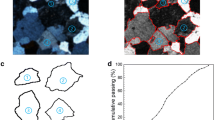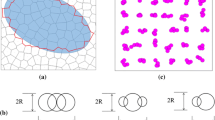Abstract
The generation of random Voronoi grain-based models for DEM simulation is proposed in this investigation. Voronoi diagram has important applications in rock engineering and geological engineering. However, the application of 3D Voronoi models has been limited due to the difficulty of generating 3D Voronoi domains. Little research has been done on the Voronoi tessellations of objects with irregular shapes. Voronoi tessellations of objects with regular and irregular shapes are investigated by using the Matlab function mpt_voronoi. The proposed models are then employed to simulate micro-fracturing and tension cracks in brittle rock. The 3D Voronoi grain-based slope model is used to investigate the dynamic response and failure mechanism of the rock slopes during earthquakes. The failures of rock slopes are actually due to the increasing and expanding of the tension cracks, the development of the tension surfaces and sliding of the blocks during earthquakes. The 2D Voronoi grain-based specimen composed of clusters is adopted to carry out rock fragmentation by TBM cutters. PFC simulation results reveal that the damaged rock undergoes some volume dilation that causes the expansion of the crushed zone and the propagation of the vertical crack. The rock fragmentations are actually caused by the increasing of the tension cracks. According to the simulation, it is believed that Voronoi grain-based models will contribute to an improved knowledge of DEM simulation.











Similar content being viewed by others
References
Cundall, P.A., Hart, R.D.: Development of Generalized 2-D and 3-D Distinct Element Programs for Modeling Jointed Rock. Itasca Consulting Group Inc, Minneapolis (1985)
Gao, F.Q., Stead, D.: The application of a modified Voronoi logic to brittle fracture modelling at the laboratory and field scale. Int. J. Rock Mech. Min. Sci. 68, 1–14 (2014)
Potyondy, D.O.: Simulation stress corrosion with a bonded-particle model for rock. Int. J. Rock Mech. Min. Sci. 44(5), 677–691 (2007)
Cundall, P.A., Strack, O.D.L.: A discrete element model for granular assemblies. Geotechnique 29(1), 47–65 (1979)
Jing, L.: A review of techniques, advances and outstanding issues in numerical modelling for rock mechanics and rock engineering. Int. J. Rock Mech. Min. Sci. 40, 283–353 (2003)
Potyondy, D.O.: The bonded-particle model as a tool for rock mechanics research and application: current trends and future directions. Geosyst. Eng. 18(1), 1–28 (2015)
Cho, N., Martin, C.D., Sego, D.C.: A clumped particle model for rock. Int. J. Rock Mech. Min. Sci. 44, 997–1010 (2007)
Hsieh, H.-H., Tai, W.-K.: A simple GPU-based approach for 3D Voronoi diagram construction and visualization. Simul. Model. Pract. Theory 13(8), 681–692 (2005)
Alzo’ubi, A.M.: The Effect of Tensile Strength on the Stability of Rock Slopes. Ph.D. thesis. University of Alberta. (2009)
Christianson, M., Board, M., Rigby, D.: UDEC Simulation of Triaxial Testing of Lithophysal Tuffs. In: Proceedings of the 41st U.S. Rock Mechanics Symposium, ARMA-06-968. (2006)
Shin, W.S.: Excavation Disturbed Zone in Lac du Bonnet Granite. Ph.D. thesis. University of Alberta. (2010)
Lan, H., Martin, C.D., Hu, B.: Effect of heterogeneity of brittle rock on micromechanical extensile behavior during compression loading. J. Geophys. Res. 115, 1–14 (2010)
Kazerani, T., Zhao, J.: Micromechanical parameters in bonded particle method for modeling of brittle material failure. Int. J. Numer. Anal. Methods Geomech. 34(18), 1877–1895 (2010)
Fernandes, D.T., Cheng, L.Y., Favero, E.H., Nishimoto, K.: A domain decomposition strategy for hybrid parallelization of moving particle semi-implicit (MPS) method for computer cluster. Clust. Comput. 18, 1329–1364 (2015)
Dorronsoro, B., Nesmachnow, S.: Special issue on soft computing techniques in cluster and grid computing systems. Clust. Comput. 17, 153–154 (2014)
Damjanac, B., Fairhurst, C.: Evidence for a long-term strength threshold in crystalline rock. Rock Mech. Rock Eng. 43, 513–531 (2010)
Zhang, C., Suzuki, A., Ishimaru, T., Enomoto, M.: Characterization of three-dimensional grain structure in polycrystalline iron by serial sectioning. Metall. Mater. Trans. 35(7), 1927–1933 (2004)
Döbrich, K., Rau, C., Krill III, C.: Quantitative characterization of the three-dimensional microstructure of polycrystalline Al–Sn using X-ray microtomography. Metall. Mater. Trans. 35(7), 1953–1961 (2004)
Quey, R., Dawson, P.R., Barbe, F.: Large-scale 3D random polycrystals for the finite element method: generation, meshing and remeshing. Comput. Methods Appl. Mech. Eng. 200, 1729–1745 (2011)
Itasca Consulting Group, Inc.: Universal Distinct Element Code: Theory and Background[R]. Itasca Consulting Group, Inc., Minneapolis (2013)
Itasca Consulting Group, Inc.: 3 Dimensional Distinct Element Code: Theory and Background[R]. Itasca Consulting Group, Inc., Minneapolis (2013)
Ghazvinian, E., Diederichs, M.S., Quey, R.: 3D random Voronoi grain-based models for simulation of brittle rock damage and fabric-guided micro-fracturing. J. Rock Mech. Geotech. Eng. 6, 506–521 (2014)
Itasca Consulting Group, Inc.: Particle Flow Code in 2 Dimensions (PFC2D), Version 4.0. ICG, Minneapolis (2008)
Itasca Consulting Group, Inc.: Particle Flow Code in 3 Dimensions (PFC3D), Version 4.0. ICG, Minneapolis (2008)
Potyondy, D.O., Cundall, P.A.: A bonded-particle model for rock. Int. J. Rock Mech. Min. Sci. 41(8), 1329–1364 (2004)
Keefer, D.K.: Landslides caused by earthquakes. Geol. Soc. Am. Bull. 95, 406–421 (1984)
Keefer, D.K.: Rock avalanches caused by earthquakes: source characteristics. Science 223, 1288–1290 (1984)
Keefer, D.K.: Investigating landslides caused by earthquakes—a historical review. Surv. Geophys. 23, 473–510 (2002)
Liu, Y.Q., Li, H.B., Zhao, J., Li, J.R., Zhou, Q.C.: UDEC simulation for dynamic response of a rock slope subject to explosions. Int. J. Rock Mech. Min. Sci. 41(1), 599–604 (2004)
Cook, N.G.W., Hood, M., Tsai, F.: Observations of crack growth in hard rock loaded by an indenter. Int. J. Rock Mech. Min. Sci. Geomech. Abstr. 21(2), 97–107 (1984)
Alvarez Grima, M., Miedema, S.A., van de Ketterij, R.G., et al.: Effect of high hyperbaric pressure on rock cutting process. Eng. Geol. 196, 24–36 (2015)
Christian, E., Robert, S., Peter, E.: A discrete element model to describe failure of strong rock in uniaxial compression. Granul. Mater. 13(4), 341–364 (2011)
Li, X.B., Summers, D.A., Rupert, G., Santi, P.: Experimental investigation on the breakage of hard rock by the PDC cutters with combined action modes. Tunn. Undergr. Sp. Technol. 16(2), 107–114 (2001)
Kaitkay, P., Lei, S.: Experimental study of rock cutting under external hydrostatic pressure. J. Mater. Process. Technol. 159, 206–213 (2005)
Pang, S.S., Goldsmith, W.: Investigation of crack formation during loading of brittle rock. Rock Mech. Rock Eng. 23, 53–63 (1990)
Hoe, E., Martin, C.D.: Fracture initiation and propagation in intact rock—a review. J. Rock Mech. Geotech. Eng. 6, 287–300 (2014)
Liu, H.Y., Kou, S.Q., Lindqvist, P.A., et al.: Numerical simulation of the rock fragmentation process induced by indenters. Int. J. Rock Mech. Min. Sci. 39(4), 491–505 (2002)
Kou, S.Q., Lindqvist, P.A., Tang, C.A., Xu, X.H.: Numerical simulation of the cutting of inhomogeneous rocks. Int. J. Rock Mech. Min. Sci. 36, 711–717 (1999)
Su, O., Ali Akcin, N.: Numerical simulation of rock cutting using the discrete element method. Int. J. Rock Mech. Min. Sci. 48, 434–442 (2011)
Cho, J.W., Jeon, S., Yu, S.H., Chang, S.H.: Optimum spacing of TBM disc cutters: a numerical simulation using the three-dimensional dynamic fracturing method. Tunn. Undergr. Space Technol. 25(3), 230–244 (2010)
Linqvist, P.A.: Rock Fragmentation by Indentation and Disc Cutting. Ph.D. thesis. University of Lulea. (1982)
Tan, X.C., Kou, S.Q., Lindqvist, P.A.: Application of the DDM and fracture mechanics model on the simulation of rock breakage by mechanical tools. Eng. Geol. 49(3), 277–284 (1998)
Acknowledgements
This work was financially supported by National Natural Science Funds (Nos. 50878123 and 11072257), National Natural Science Funds for Distinguished Young Scholar (No. 51025935 and No. 51009086) and Major State Basic Research Development Program of China (973 Program) (No. 2010CB732001). Young Scholars Development Fund of SWPU (201599010101).
Author information
Authors and Affiliations
Corresponding author
Rights and permissions
About this article
Cite this article
Lv, Y., Li, H., Zhu, X. et al. Discrete element method simulation of random Voronoi grain-based models. Cluster Comput 20, 335–345 (2017). https://doi.org/10.1007/s10586-016-0705-3
Received:
Revised:
Accepted:
Published:
Issue Date:
DOI: https://doi.org/10.1007/s10586-016-0705-3




